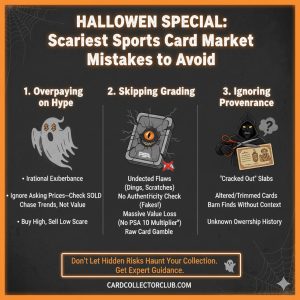The sports card market can be thrilling, but like any good haunted house, it’s also full of hidden traps and jump scares for the unprepared. This Halloween, we’re shining a flashlight on the most terrifying mistakes collectors make, helping you navigate the market without succumbing to ghoulish regrets. Let’s unmask the scariest sports card market blunders and learn how to avoid them.
Beware These Market Monsters!

From overpaying for fool’s gold to overlooking critical details, these missteps can truly haunt your collection.
1. Overpaying on Hype: The “Ghost” of Missing Value
One of the most common and costly mistakes is getting swept up in irrational exuberance. A player has a breakout week, and suddenly, their raw rookie card triples in price on eBay. Without proper research and a cool head, you might find yourself holding a card that quickly depreciates once the hype dies down.
How to avoid this specter:
- Consult Sold Listings, Not Asking Prices: Always check completed eBay sold listings or auction house results for a realistic market value. Asking prices often reflect seller optimism, not true market demand.
- Track Performance Trends: A single good game doesn’t make a Hall of Famer. Look at a player’s season-long or career-long trajectory. Is their performance sustainable?
- Understand Market Cycles: Prices often surge during a player’s hot streak, then correct. Buying at the peak of a “hype cycle” is a recipe for regret.
- “Buy the rumor, sell the news” is a common market adage. For cards, this often means prices rise before a major achievement (like an MVP announcement) and may even dip slightly after the news breaks, as early investors cash out.
2. Skipping Grading: The “Phantom” of Hidden Flaws
Many collectors, particularly newer ones, try to save money by avoiding professional grading. While this might seem like a cost-saver upfront, it’s a terrifying gamble in the long run. An ungraded card, no matter how perfect it looks to the naked eye, carries significant risk.
Why Skipping Grading is Spooky:
- Undetected Damage: Raw cards often harbor subtle defects, a tiny ding on a corner, a surface scratch, or minor print lines that only trained eyes (and magnification) can spot. What you think is a Gem Mint could easily be an or.
- Lack of Authenticity: Counterfeit cards and altered cards are a growing threat. Professional grading services like PSA verify authenticity, protecting you from buying a fake.
- Massive Value Discrepancy: As an authorized PSA dealer, we’ve seen countless examples where a PSA 10 of a key rookie sells for 5x, 10x, or even 20x the price of a raw copy. Skipping grading means leaving significant money on the table.
- Example: A raw 1986 Fleer Michael Jordan rookie might fetch on a good day. A PSA sells for around to, and a PSA can command and up (prices vary wildly by market conditions). That’s a monumental difference!
3. Ignoring Provenance: The “Curse” of Unknown History
Provenance refers to a card’s history of ownership. For high-value cards, especially vintage ones, understanding where a card has been can be crucial. Lack of provenance can be a red flag, hinting at potential issues like alterations, undisclosed repairs, or even theft.
What to look out for:
- “Cracked Out” Cards: Be wary of cards removed from their original graded slab. While sometimes legitimate (e.g., for cross-grading), it can also be a tactic to hide a lesser grade or alteration.
- “Freshly Trimmed” Vintage: Stories of unscrupulous individuals trimming vintage cards to improve edge ratings are legendary and horrifying. Buying from a reputable dealer or only purchasing professionally graded cards is your best defense.
- “Barn Finds” without Context: While exciting, a “barn find” without any backstory from a verified source should raise questions. Where did it come from? Why is it suddenly appearing now?
As a PSA Authorized Dealer, we emphasize the importance of dealing with established, trustworthy businesses. Our “About Us” page details our commitment to transparency and ethical practices: Learn More About Us
FAQs: Shining a Light on Common Fears
What if I buy a graded card and it turns out to be a fake slab?
A: This is a terrifying thought, but thankfully, rare when dealing with reputable sources. Always verify the certification number on the grading company’s official website (e.g., PSA’s cert verification tool). Be suspicious of deals that seem too good to be true, and avoid third-party sellers without strong feedback.
Is it always a mistake to buy raw cards?
A: Not always. For modern, common cards you intend to keep for your personal collection without a focus on investment, raw is fine. However, for any card you deem valuable or intend to resell, raw is always a risk. If you buy raw, assume you are either buying at a discount for its condition or you are confident it will grade highly after a professional submission.
Don’t Let Fear Dictate Your Collection
The sports card market can be incredibly rewarding, but only if you arm yourself with knowledge and caution. By avoiding these scary market mistakes, overpaying on hype, skipping grading, and ignoring provenance, you can build a collection that brings joy, not dread.
Don’t let hidden risks haunt your collection. Get expert guidance today.
